

The high rate of change which characterised 1982 continued throughout 1983. The installation of an ICL Atlas 10 completed the mainframe processor replacement plan and allowed the IBM 3032 to be used to introduce a service for SERC administration. A solid state paging unit and a cartridge storage device were delivered in September, immediately followed by the replacement of the IBM 3081 with a new version. The introduction of an internal MVS batch operating service in October was the first milestone on the way to replacing the MVT system. The services of the GEC and PRIME computers for interactive computing continued to be enhanced.
Following decisions by the DES Computer Board for Universities and the Research Councils and by SERC, a joint academic network (JANET) based on the X25 protocol is being set up, taking over a large proportion of the current SERC network. The formal move should be complete in April 1984 and comes after a great deal of work by RAL staff in developing protocols and exchange software.
The major event of the year was the installation of the Atlas 10. This is a 15 MIP (million instructions per second) single processor which has 16 channels for communicating with peripheral devices such as disks, tapes, telecommunications controllers, etc and has 16 megabytes of main memory. It is IBM-compatible in the sense that it supports IBM operating systems such as VM and MVS.
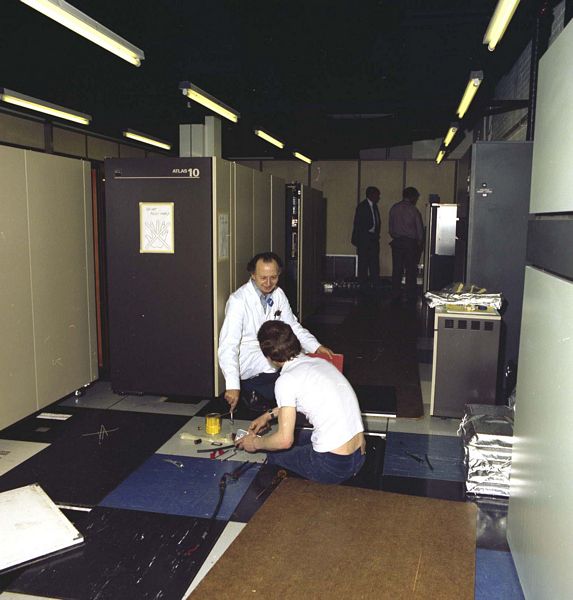
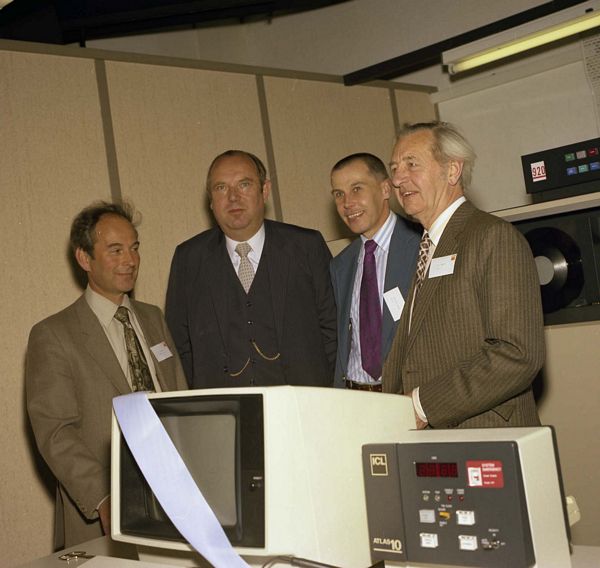
The Atlas was installed in April and very quickly passed its acceptance tests including several runs of the RAL benchmark suite of jobs under MVS. There followed a period of time shared with ICL during which the RAL periods of access to the machine were used for operator training and software validation, with particular emphasis on running MVT under VM. A production service began early in June with the back-end MVT system (BEM) running on the Atlas 10 during RAL access and on the IBM 3032 at other times.
The Atlas 10 was handed over fully on 16 August when it took over the back-end role completely. Since then it has performed very well as a batch processor and is particularly good at processing the scientific workload. Its installation more than doubled the installed CPU power. Fig 5.1 shows the changes in CPU power of the central computing complex over the last decade.
In September the IBM 3032 service ended and work started on using this machine for the SERC Administrative Computing project. This has involved the purchase of a solid state storage device for the central system to replace the IBM fixed-head files, which have become part of the 3032 Administrative Computing system. Accordingly, a Memorex 3864 48 megabyte device was installed in early September. Since then, it has been used as a paging device for the VM operating system on the IBM 3081. It has been very reliable and has given increased performance.
A Masstor M860 was delivered in September. This is a 110 gigabyte cartridge store. Program development is required for this device which will be put into service early next year. The cartridge store (Fig 5.2) consists of a honeycomb of storage units each holding one cartridge containing 60 feet of wide magnetic tape which holds up to 175 megabytes of data. The device automatically loads the cartridges into one of two read stations. Initially, the M860 will be used as a migration device for datasets in the IBM MVS operating system.
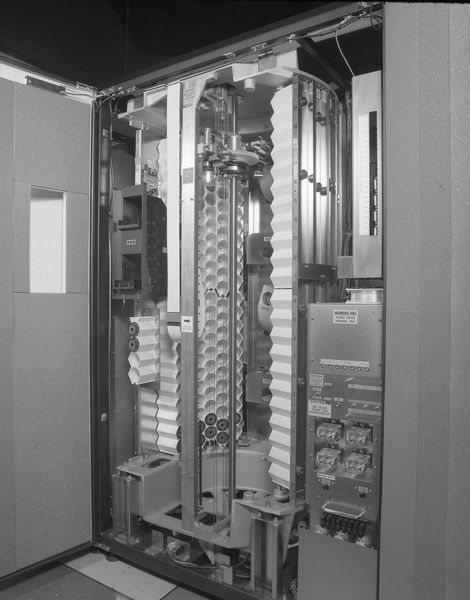
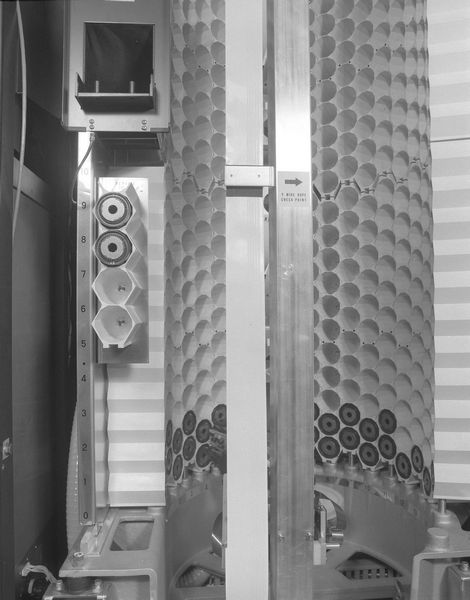
In October, the 3081 was taken out of service and replaced a few days later by a new version of the same processor. This was to enable the memory to be increased from 16 to 32 megabytes. The present system is 24 megabytes and the final 8 megabytes is due to be installed early next year. During the exchange of the two 3081 processors, the service was maintained by running the interactive and batch services on the Atlas 10.
The FR80 microfilm recorder has continued in service throughout the year. The launch of the IRAS satellite gave rise to a dramatic increase in the demand for microfiche output. The principal output of the device this year has been about 57,000 frames of hardcopy and 73,000 microfiche. Small amounts of 16 mm and 35 mm film have also been produced. The device is now showing signs of age and this has occasionally led to problems with the quality and reproducibility of output. Studies are in progress to identify suitable replacement devices.
A front-end MVT system (FEM) has continued to run under the VM (virtual machine) operating system on the 3081 supporting the ELECTRIC service and some workstations still controlled by the spooling sub-system, HASP. The MVT batch service was provided initially by another MVT system (CEM) on the 3081 and a third MVT system (BEM) running native on the 3032. With the acceptance of the Atlas 10 and the transfer of the 3032 to the Administrative Computing project, the BEM was moved into the Atlas to run under a second VM system and the CEM was phased out. Both the FEM and the BEM were increased in size to 8 megabytes to allow the running of very large core jobs. The only significant modification to the MVT system was the change to 4K storage protection keys instead of 2K keys. This change was necessary in order to support the new 3081. Development of the MVS system has continued and an internal divisional trial system was installed in October, running in a virtual machine in the Atlas 10 for two hours each day. An external trial is scheduled for February 1984 with a projected date of July 1984 for a full production system. There will then be a short overlap period before MVT is phased out.
Owing to the imminent closure of ELECTRIC, significant effort has been devoted to moving files out of the ELECTRIC filestore. The ARCHIVE command was removed at the end of June and all level 2 archived files have been moved to level 1. With the service closed, there should be sufficient space to restore all the archived files leaving the on-line filestore accessible from CMS in read-only mode.
The EXEC command was removed at the end of September so that no further job submission could take place. The transfer of users to CMS and other systems has proceeded smoothly throughout the year.
The increased use of CMS has taken the number of logged-in users to over 100 at peak times with 60-70 active simultaneously. Response to trivial commands has been maintained with over 90% given sub-second response.
Release 2 of CMS was installed early in the year. The main feature of this was a new mail system which replaced the locally written RMAIL. The new system has been interfaced to the Computing Division mail service using File Transfer Protocol to communicate with the mail server machine.
New service levels of the Control Program have been installed although it has not been possible to go to release 2 because it does not support multi-processors. A VM system was generated for the Atlas 10 and VM/HPO (High Performance Option) was installed on the new 3081 to support the increase in memory.
A new batch sub-system was installed in CMS to provide more flexibility to users who wish to run their batch jobs under CMS rather than MVT/MVS. The system provides a facility for scheduling and monitoring batch jobs in the VM/CMS environment. The system is controlled by a supervising virtual machine which dispatches and monitors other virtual machines to run the jobs. Jobs can be assigned to different classes depending on their CPU, print and punch requirements. It is also possible to specify a start time window during which the job may be run.
The CMS implementation of FTP has been made to support direct job submission to MVT batch and automatic retrieval of MVT job output to any network destination. Job input (or output) can also be routed to remote systems such as CERN or DESY. Job output from these remote systems can be routed to any network destination by making use of the appropriate Job Control Language.
The development of accounting systems for the MVS service has been a major task. This has also required decisions on new charging methods which more accurately reflect the impact of a job on the MVS system. It is no longer sufficient to use CPU time alone as a measure of a job as the capacity to include I/O, memory size, disk space and other factors must be planned into any modern accounting system. The decisions about accounting have been planned in collaboration with Daresbury Laboratory which is involved in a similar conversion exercise. Both the retrospective accounting system and the online control system in MVS will be new and based on the concept of an Allocation Unit as the measure of a job. There are differences in most areas and new items of software have been introduced. This has so far meant that education and design have gone hand in hand. Much has been achieved in this area although considerable work remains.
The MVS system has also caused significant developments to take place in the area of machine performance where new software tools have been developed and preparations have been made to tune the new system.
The regular work of provision of accounting data, registering users, monitoring resource allocation and reporting to Boards has continued as usual.
During the year work has concentrated on internal systems and on plans for expanded and improved user-level systems. Continuation of the work towards implementing the Graphics Kernel System (GKS) version 7.2 has taken most effort. GKS 7.2, a draft International Standard with which staff from Computing Division have been heavily involved, has gained a great deal of world-wide support during the year. It will run initially on VAX and PERQ computer systems; during 1984 it will also be made available on IBM and PRIME computers.
Availability of the other main graphics systems (GINO-F on PRIME, GEC, IBM and SMOG on IBM) will not be affected by GKS; support and maintenance of these systems has continued throughout the year. Much effort has been devoted to planning documentation of GKS and of the graphics systems on PRIME and GEC.
A new version of DRAFT, a diagram layout program which incorporates a large number of suggestions from users, was installed under CMS; the new facilities provide improved colour support, controllable line width and use of the cursor for the drawing of most objects. In addition, the user may now edit the transcript of a session, thereby gradually building up a complete file.
Most of the work for Starlink has been devoted to the implementation of GKS 7.2 but there has also been the regular maintenance work on GKS 6.2 which will remain the standard basic Starlink graphics software until GKS 7.2 is distributed.
The molecular drawing program PLUT078 has been further enhanced (see Fig 5.3) and a user reference manual issued. The program is available centrally on the CMS system and has been moved to several GEC sites where managers have requested that it be made more accessible by running it locally. A demonstration set of diagrams is now in regular use; it was seen recently, for example, by visitors to the Oxford meeting of the IBM European User Group.
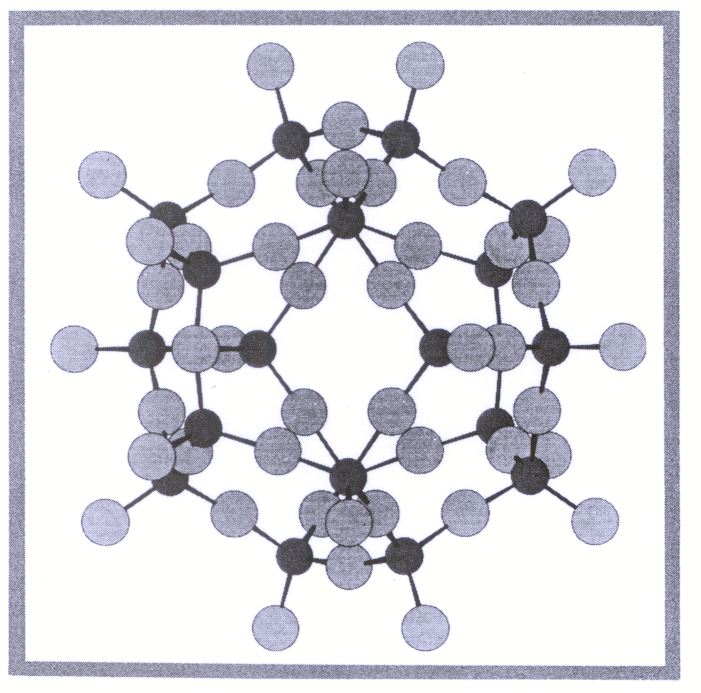
Early in the year, programs were moved from RAL to Cambridge where magnetic tapes were generated to make a reference set of 23 microfiches. These contain several different orders of index to the complete contents of their database which now contains information on over 38,000 crystal structures.
In May, 764 pages of hardcopy paper were produced as the camera-ready copy for Volume 14 of the series Molecular Structures and Dimensions. Organic and Organometallic Crystal Structures. Bibliography 1981-82. This contains 7 indices in different orders to more than 6,200 references and cross-references, including an index of 4,000 chemical diagrams.
PLUT078 has been used for some of the molecular sequences in a computer-animated 16 mm colour film made on the FR80 microfilm recorder. The film, Silicates in Solution, attempts to show the possible ways in which silicate groups combine and recombine as solution conditions change. It was made in collaboration with the University of Aberdeen and first shown at an international conference on zeolites in Nevada in July.
New programs were written to produce the film titles and to display shaded tetrahedral sequences interactively thus reducing the amount of manual effort needed to prepare the film.
The growth in database activity this year reflects the expanding interest in databases in the Laboratory. Database technology is now used in a wide range of applications in both the scientific and administrative work of SERC, viz administrative database systems for Central Office and the Laboratory and scientific database systems supported by database management systems and software packages either purchased or developed elsewhere and used by SERC staff. These are the relational database packages INFO and G-EXEC and the free text retrieval program STATUS. For transaction processing, TOTAL and, increasingly, DL/l are used.
The automating of office functions is becoming increasingly important as a method of improving efficiency within an organisation. Office Automation does not merely cover word processing but includes electronic mail, electronic filing and retrieval, access to administrative databases, etc. The Laboratory is involved in two major activities: an internal pilot project to examine the usefulness of these functions, and two projects involving the Department of Trade and Industry (DTI), Central Office, Office Technology Ltd (OTL) and International Computers Ltd (ICL).
Computing and Administration Divisions have jointly established a six-month pilot project in office automation embracing a limited set of office staff on the RAL site. The system under evaluation is the IBM PROFS package (PRofessional OFfice System). PROFS consists of a set of VM/CMS-based application programs designed to support a wide range of office activities via full screen terminals. In machine terms it requires a configuration equivalent to an IBM 4331 or larger, a minimum of 1 Mbyte of main storage, and discs for which there is VM/SP support. Networking to terminals, printers etc. uses VNET. It is a menu-driven system which makes extensive use of the PF (program function) keys available on 3270-type terminals.
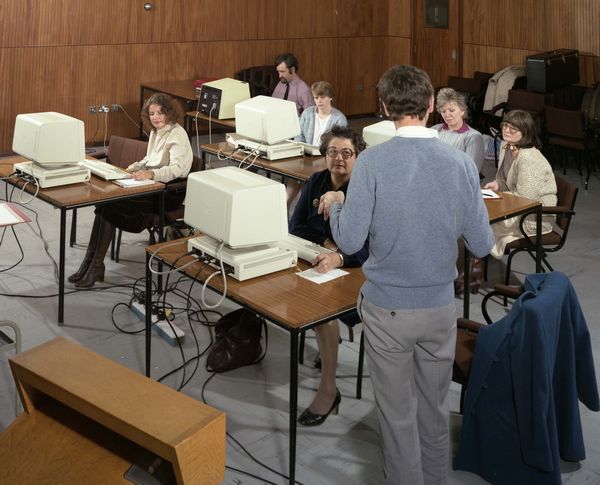
A major feature of PROFS is its relationship to other IBM products. Since it uses the standard CMS file store for storage of information, many housekeeping functions and CMS utilities are available to the PROFS user. For text production, it uses the IBM Document Composition Facility (DCF), which includes spelling verification as well as the normal word-processing functions. The PROFS overall design is sufficiently flexible to cater for a broad spectrum of potential users. At one extreme, someone with little or no knowledge of computer systems can use it very effectively and be completely unaware of the substructure on which the system depends but an expert user is free to exploit his or her knowledge of CMS and DCF.
The office activities to which the PROFS package will be applied during the RAL experiment include:
About 70 users are participating in the experiment drawn mainly from General Administration, Finance and Personnel Sections, plus some Heads of Division, secretaries and typists. Approximately 30 terminals are being installed together with matrix and letter-quality printers to give an overall terminal-printer ratio of about 4:1. As the pilot progresses, further decisions will be taken on its possible expansion.
Both Central Office and RAL have been using word processors as stand-alone devices for several years. In addition, researchers having access to a network have made use of message-passing facilities to communicate with each other and have also used the text-processing systems provided on computers. A number of different word processors have been installed, and there is considerable interest in their interconnection.
The Laboratory has a long history of collaboration with ICL, the most recent being the provision of software on the PERQ single- user machines. The PERQ is the current SERC standard for the provision of computing power to a single user and is expected to be widely available. The DTI Office Automation Pilot Project has been set up to obtain practical experience in the application of office automation systems and to provide for industry a realistic proving ground for advanced technology. Some 20 pilot projects have been set up in the UK. SERC is cooperating in this initiative in two ways: using equipment provided by OTL, and, in a separate but related project, equipment provided by ICL. The projects rely heavily on the development of new hardware and software and the interconnection of equipment from different manufacturers.
The two projects are based at both RAL and Central Office. One pilot involves the interconnection of OTL Diamond 7 Word Processors, making it possible to transfer files between locations on a single site and between RAL and Central Office. The other interconnects ICL PERQs with special text-processing software. Both will use Cambridge Rings at RAL and Central Office, which in turn will be connected by the SERC network. GEC 4000 series machines will provide backup storage on both rings. The size of the RAL site means that the Local Area Network required is large, approaching the maximum size used experimentally anywhere in the world.
It is worthy of note that all the items of equipment needed to connect hosts to rings and ring gateways were major development projects commissioned in industry by RAL and the Joint Network Team and are now being marketed.
OTL has written the software for the Diamond 7s at Central Office and RAL and they can now communicate with each other around the local ring at each site. Work on the PERQs is not so far advanced. Equipment is awaited to enable the GECs and the two rings to be connected. A DTI evaluation of both projects is under way.
A Summer School entitled Good Practices in the Production and Testing of Software was held at Easter for SERC staff. Salford University staff gave most of the lectures, which were interspersed with presentations on aspects of SERC computing by staff from SERC laboratories. The School was considered successful and another is planned for 1984.